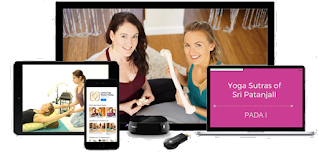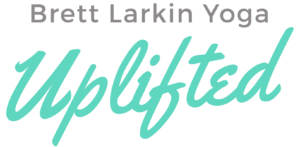Ever feel like your body is one giant knot?
Like no matter how much you stretch, there’s still some lingering tightness that just won’t let go?
You’re not imagining it—it’s probably your fascial system, the web of connective tissue that holds everything together.
Unlike muscles, which we can consciously contract and release, fascia responds to emotional stress, posture, and even emotions in ways we don’t always notice—until we’re stiff, sore, and wondering why our downward dog feels more like a downward struggle.
The good news? Yoga can help.
By understanding how myofascial pain works and incorporating mindful movement, like yoga or physical therapy, you can create more space, release restriction, and move with greater ease.
What Is Fascial Tension?
Fascial tension refers to tightness or restriction in the fascial system. It’s more than just muscle tension. So, what is fascia? It’s the connective tissue that surrounds muscles, bones, and organs.
When fascia and muscle tissue become dehydrated, overworked, or stressed, they can stiffen and limit mobility in the entire body, leading to discomfort, muscle tension pain, poor posture, and reduced flexibility and range of motion.
Many people with chronic pain actually have both muscle pain and deep fascia pain. This type of tension plays a key role in myofascial pain syndrome (MPS), a chronic condition where tight, sensitive areas in the fascia—called trigger points—cause pain and stiffness.
When fascia becomes restricted due to stress, poor posture, or injury, it can create adhesions and limit blood flow in muscle fibers, leading to persistent discomfort and referred pain in other areas of the body.
Myofascial pain syndrome in the deep fascia is extremely common. Almost everyone experiences some degree of tightness in fascial tissues due to factors like poor posture, repetitive movements, stress, dehydration, restricted blood vessels, and lack of mobility.
When left unchecked, this tension can contribute to stiffness, restricted movement, and even chronic pain conditions like myofascial pain syndrome (MPS). This often shows up as weak muscles, delayed onset muscle soreness, shoulder pain, muscle tension, musculoskeletal pain, and joint pain.
Myofascial pain isn’t just a structural issue—it’s also tied to emotional and energetic blockages.
Yoga, breathwork, and myofascial release therapy help release fascial restrictions, improve circulation, and restore balance, addressing both the physical and emotional aspects of pain.
It isn’t just a physical issue—it’s an energetic one. Fascia responds to movement, breath, and even emotions, making yoga a powerful tool for release.
I like to think of this connective tissue, known as fascial tissues, as flaring up when your body is asking for attention—whether physically, emotionally, or energetically.
By incorporating slow, mindful stretching, myofascial techniques, and myofascial trigger point therapy, you can hydrate and soften the fascia, restoring both physical ease and energetic flow.
Experience 3 Training Videos from Inside My 200-Hour Online YTT 👇
Causes Of Fascial Tension
Myofascial pain syndrome (MPS) develops when tight, sensitive areas in the fascia—known as trigger points—cause pain, stiffness, and referred discomfort in other parts of the body. This chronic condition often arises from a combination of physical, lifestyle, and emotional factors, leading to persistent tightness and reduced mobility. Unlike temporary muscle soreness, MPS doesn’t simply go away with rest—it requires targeted movement, hydration, and stress relief to help release the underlying fascial restrictions. Below are some of the most common causes of myofascial pain syndrome and how they contribute to long-term discomfort.
Poor Posture
Slouching at a desk, hunching over a phone, or standing with misaligned weight distribution places uneven stress on fascia, leading to trigger points that cause pain and restricted movement. Since fascia is interconnected, poor posture doesn’t just affect one area—it creates a chain reaction throughout the body. A forward head posture, for example, can cause neck and shoulder pain, while a misaligned pelvis may lead to lower back tightness and myofascial discomfort.
Repetitive Movements
Whether you’re an athlete, a musician, or someone who types all day, repetitive movements can overwork certain muscle groups, causing the fascia around them to become thick, tight, and prone to developing painful trigger points. Runners often experience tightness in the IT band, while office workers may develop chronic tension in the wrists, shoulders, and neck due to prolonged computer use. Without proper counter-movements and stretching, this repetitive strain can lead to myofascial pain syndrome.
Inactivity & Lack of Movement
Just as repetitive motion can contribute to MPS, too little movement can have the same effect. When we’re inactive, fascia becomes dehydrated and stiff, leading to tightness that feels difficult to release. This is why people often wake up feeling stiff in the morning or experience discomfort after sitting for long periods. Without regular stretching and mobility exercises, fascia forms adhesions that restrict movement and contribute to trigger point pain.
Stress & Emotional Tension
Fascia is highly responsive to stress and emotions, meaning chronic tension from anxiety, trauma, or mental strain can manifest as myofascial pain. When under stress, the body tends to contract—jaw clenching, shoulder shrugging, and abdominal tightening are all common responses. Over time, these subconscious tension patterns create fascial restrictions and trigger points that don’t just disappear once the stressor is gone. This explains why massage or deep stretching can sometimes bring up emotional releases—the fascia is unwinding stored stress along with physical tension.
Dehydration
Fascia is made mostly of water and relies on proper hydration to remain supple and elastic. When dehydrated, fascia loses its ability to glide smoothly over muscles, leading to stiffness, adhesions, and myofascial discomfort. This dehydration-related tightness can make movement feel restricted, and trigger points become more painful when fascia lacks proper hydration. Drinking water and consuming hydrating foods (like fruits and vegetables) help keep fascia pliable and reduce myofascial pain syndrome symptoms.
Injury & Trauma
Injuries, surgeries, or even minor accidents can create scar tissue and adhesions in fascia, leading to chronic pain and limited mobility. Myofascial pain syndrome can develop when fascia tightens around an injured area, restricting blood flow and creating persistent discomfort. For example, an old ankle sprain may result in knee, hip, or back tightness due to compensatory movement patterns. Without proper rehabilitation and fascial release techniques, these restrictions can last for years, leading to ongoing pain.
Aging & Reduced Collagen Production
As we age, the body naturally produces less collagen, an essential protein that keeps fascia elastic and resilient. With reduced collagen levels, fascia becomes prone to stiffness and adhesions, increasing the risk of developing myofascial trigger points. While aging is inevitable, staying hydrated, consuming collagen-rich foods (such as bone broth and leafy greens), and engaging in regular movement can help maintain fascial health and reduce myofascial pain syndrome symptoms.
The good news? Fascia is adaptable, and with the right self-care practices, you can reduce myofascial pain and restore mobility. Yoga, myofascial release techniques (foam rolling, massage), deep stretching, hydration, and stress management all help to prevent and alleviate myofascial pain syndrome symptoms. By recognizing the underlying causes, you can take proactive steps to release tight fascia, prevent trigger points, and move with greater ease.
Benefits Of Myofascial Release
Myofascial release (MFR) is a powerful practice for alleviating chronic pain and myofascial pain syndrome, improving mobility, and enhancing overall well-being by targeting the fascia—the connective tissue that surrounds and supports muscles.
Myofascial release techniques help to break up adhesions, hydrate tissues, and release trigger points, allowing for greater movement and reduced discomfort. Research has shown that myofascial release can significantly improve flexibility, circulation, and nervous system function (Beardsley & Škarabot, 2015). Whether performed through foam rolling, manual therapy, or assisted stretching, here are some of the key benefits of incorporating myofascial release into your routine:
- Reduces Chronic Pain – Myofascial release targets trigger points that contribute to chronic pain conditions such as myofascial pain syndrome, fibromyalgia, and tension headaches. Studies indicate that MFR can reduce musculoskeletal pain and improve overall comfort (Ajimsha et al., 2015). For example, a person suffering from persistent lower back pain may find relief by releasing tight fascia in the hip flexors and hamstrings.
- Enhances Flexibility & Mobility – Tight fascia can restrict movement and cause stiffness, making everyday activities more challenging. Myofascial release helps the fascia regain its elasticity, allowing muscles and joints to move more freely. This is particularly beneficial for athletes, dancers, and yoga practitioners, who rely on full range of motion for performance.
- Improves Circulation & Tissue Hydration – Fascia needs hydration and blood flow to stay healthy, but restrictions can limit circulation. Myofascial release increases blood flow to muscles and connective tissue, delivering oxygen and nutrients while flushing out metabolic waste. This is why many people experience a warming sensation and increased relaxation after a session.
- Supports Postural Alignment – Poor posture can lead to imbalanced fascial tension, resulting in pain and restricted movement. Releasing tight fascia in the neck, shoulders, and lower back can help restore natural alignment, reducing discomfort from prolonged sitting or repetitive movement patterns.
- Aids in Recovery & Injury Prevention – By improving tissue elasticity and reducing adhesions, myofascial release helps prevent injuries related to overuse, poor movement mechanics, and muscular imbalances. Athletes and fitness enthusiasts often incorporate MFR to speed up recovery after workouts and prevent common injuries like shin splints, IT band syndrome, and plantar fasciitis.
- Promotes Relaxation & Reduces Stress – Since fascia is connected to the nervous system, releasing tension in the body can help calm the fight-or-flight response, reducing stress, anxiety, and muscle tension. Many people find MFR deeply relaxing, similar to the effects of a massage or restorative yoga practice.
- Supports the Lymphatic System & Detoxification – Fascia plays a role in lymphatic drainage, which helps the body remove toxins and waste products. Releasing tight fascia encourages lymphatic flow, reducing inflammation and supporting immune function. This is especially beneficial for those dealing with chronic swelling, fluid retention, or post-injury recovery.
Incorporating Myofascial Release Into Your Routine
To experience these benefits, try incorporating myofascial release into your yoga practice, post-workout routine, or evening wind-down ritual. Foam rolling, massage therapy, or using myofascial release balls can help target specific areas of tightness and restore balance in the body. Whether you’re dealing with chronic pain, stiffness, or stress-related tension, MFR offers a natural and effective way to improve movement, reduce discomfort, and enhance overall well-being. It’s the perfect solution for myofascial pain syndrome.
How To Maintain Health Fascia
Maintaining healthy fascia is possible through consistent self-care practices. Below are key strategies to keep your fascia supple, resilient, and free from adhesions. You don’t have to live with myofascial pain syndrome forever. Here are some steps you can start taking today to repair your connective tissue and release myofascial pain syndrom.
Stay Hydrated
Fascia is composed primarily of water, making hydration crucial for its elasticity and function. When dehydrated, fascia can become dry and sticky, leading to stiffness and discomfort. Aim to drink at least half your body weight in ounces of water per day, and consume hydrating foods like cucumbers, watermelon, and leafy greens. Electrolytes—such as those found in coconut water and mineral-rich foods—help maintain cellular hydration, ensuring fascia stays lubricated and flexible.
Incorporate Myofascial Release
Self-massage techniques like foam rolling, massage therapy, and using lacrosse balls can help release fascial adhesions and improve mobility. Myofascial release works by applying sustained pressure to areas of tension, allowing fascia to reorganize and regain its elasticity. Focus on commonly tight areas like the IT band, calves, upper back, and shoulders. Practicing 5–10 minutes of myofascial release daily can significantly reduce myofascial pain syndrome and enhance movement.
Move Consistently Throughout the Day
Sedentary lifestyles contribute to fascial stiffness and adhesions, especially when sitting for prolonged periods. Regular movement—such as stretching, walking, or taking movement breaks every hour—prevents fascia from becoming rigid. Simple activities like rolling your shoulders, twisting your spine, or stretching your arms overhead can keep fascia pliable and responsive. Incorporating diverse movement patterns into your day ensures your fascia remains adaptable and resilient, keeping myofascial pain syndrome at bay.
Practice Dynamic Stretching and Yoga
Unlike static stretching, dynamic stretching and yoga focus on fluid, controlled movements that enhance fascial elasticity and blood circulation. Poses that involve twisting, lengthening, and controlled resistance—such as Cat-Cow, Downward Dog, and spinal twists—help nourish the fascia by encouraging gentle, sustained tension. Yoga also stimulates the parasympathetic nervous system, promoting relaxation and reducing stress-related fascial tightness.
Prioritize Strength Training
While stretching keeps fascia flexible, strength training reinforces its structure. Resistance exercises like bodyweight movements, kettlebell swings, and resistance band training create healthy stress on fascia, prompting it to regenerate and stay resilient. Strength training also enhances muscular support and posture, reducing fascial imbalances that can lead to myofascial pain syndrome and dysfunction.
Support Your Body With Proper Nutrition
Healthy fascia relies on a nutrient-dense diet rich in collagen, healthy fats, and antioxidants. Foods like bone broth, salmon, chia seeds, berries, and leafy greens provide the building blocks for strong, flexible connective tissue. Vitamin C—found in citrus fruits, bell peppers, and broccoli—is essential for collagen synthesis, while omega-3 fatty acids help reduce inflammation and support tissue repair. Avoid excessive processed foods, which can contribute to systemic inflammation and fascial stiffness.
Optimize Your Sleep and Recovery
During sleep, fascia undergoes repair and regeneration, making rest essential for maintaining its health. Aim for 7–9 hours of quality sleep per night, and incorporate relaxation techniques such as deep breathing, meditation, or gentle stretching before bed to encourage fascial recovery. Overtraining without adequate recovery can lead to chronic inflammation and fascial adhesions, so balancing activity with rest is key.
Reduce Stress and Tension
Fascial tightness often correlates with chronic stress, anxiety, and emotional tension. Practices such as meditation, deep breathing exercises, and mindfulness-based movement can help downregulate the nervous system and reduce sympathetic nervous system overactivity, which can cause fascia to become rigid. Engaging in activities that promote relaxation—such as spending time in nature, taking warm baths, or journaling—can help maintain supple, stress-free fascia.
Improve Posture and Body Mechanics
Poor posture and repetitive movements can create imbalanced fascial patterns, leading to myofascial pain, chronic pain and restricted mobility. Being mindful of your posture—especially during activities like working at a desk, lifting objects, or standing for long periods—can prevent unnecessary fascial strain. Ergonomic adjustments, such as using a standing desk, maintaining spinal alignment, and incorporating core-strengthening exercises, can support long-term fascial health and reduce myofascial pain syndrome. This works great for frozen shoulder and lessen pain in muscles the fascia surrounds.
Embrace Heat and Cold Therapy
Applying heat therapy (such as warm compresses, saunas, or Epsom salt baths) can increase blood flow and promote fascial relaxation, while cold therapy (like ice baths or cryotherapy) helps reduce inflammation and muscle soreness. Alternating between heat and cold therapy—known as contrast therapy—can enhance circulation, recovery, and overall fascial health.
Yoga Poses for Myofascial Release
Yoga is one of the most effective ways to release fascial tension and promote mobility. The combination of gentle stretching, deep breathing, and mindful movement makes myofascial release yoga a powerful tool. Below are several yoga poses specifically designed to target common areas of fascial tightness, improve overall flexibility, and reduce myofascial pain syndrome.
1. Child’s Pose with a Foam Roller
Instructions:
- Start in a kneeling position, with your knees wide apart and your big toes touching.
- Place a foam roller under your chest, aligned with your sternum.
- Slowly lower your torso toward the mat, allowing your arms to extend in front of you, and rest your forehead on the ground.
- Breathe deeply and focus on releasing tension in the chest, shoulders, and spine. You can gently rock forward and back to increase the release of fascia along your back.
- Hold for 1-3 minutes, breathing deeply and allowing your body to soften into the pose.
Benefits:
- Releases tension in the upper back, chest, and shoulders.
- Relieves stress and promotes relaxation.
- Improves flexibility in the spine and hips.
- Encourages deeper breathing by opening up the chest.
2. Reclining Pigeon Pose with a Foam Roller
Instructions:
- Lie on your back and place a foam roller under your glutes on the side of the leg you want to target.
- Cross your opposite ankle over the knee of the roller-supported leg, creating a figure-four shape.
- Gently press your hips down to deepen the stretch in your glutes and outer hips, letting the foam roller work into the muscle tissue.
- Stay here for 1-2 minutes, breathing deeply into the hips and releasing any tightness.
- Repeat on the other side.
Benefits:
- Releases tightness in the glutes, hips, and outer thighs.
- Improves mobility in the hip joint.
- Reduces discomfort from sciatic nerve compression.
- Helps to relieve lower back tension.
3. Forward Fold with a Foam Roller Under Feet
Instructions:
- Stand with your feet hip-width apart, placing a foam roller under the balls of your feet.
- Slowly bend forward at the hips, bringing your torso towards your thighs, while keeping your knees slightly bent if needed.
- As you fold, press your feet down into the roller to deepen the stretch and release tension in your calves, hamstrings, and lower back.
- Let your head and neck relax, and hold for 1-2 minutes, breathing deeply into the back of your legs.
Benefits:
- Releases tension in the hamstrings, calves, and lower back.
- Improves flexibility in the legs and spine.
- Encourages relaxation through deep breathing and gentle stretching.
- Relieves stiffness in the legs and feet.
4. Chest Opener with a Foam Roller
Instructions:
- Lie on your back with a foam roller placed lengthwise under your spine, from your tailbone to your head, supporting the entire back.
- Let your arms extend out to the sides with palms facing up, or place your hands behind your head for a deeper stretch.
- Slowly open your chest and allow gravity to help stretch the front of your shoulders and chest.
- Focus on releasing any tightness in your upper back and ribs. Hold for 1-3 minutes, allowing the roller to target the fascia along your back and chest.
Benefits:
- Opens up the chest and shoulders.
- Relieves upper back and neck tension.
- Helps improve posture by stretching the muscles of the chest and upper back.
- Promotes deep breathing and relaxation.
Final Thoughts
Maintaining healthy fascia requires a holistic approach that includes hydration, movement, nutrition, stress management, and recovery. By incorporating these simple yet effective strategies into your daily routine, you can support long-term mobility, reduce pain, and improve overall physical well-being. Prioritizing fascia care is not only beneficial for movement and flexibility but also plays a crucial role in injury prevention, stress reduction, and overall vitality. Start small by adding one or two of these habits into your routine, and gradually build a lifestyle that supports resilient, healthy fascia for years to come.
There are several effective strategies that can help keep your fascia in peak condition and keep myofascial pain syndrome away. These strategies go beyond just stretching or foam rolling and involve a holistic approach to your connective tissue that includes physical therapy, hydration, movement, nutrition, stress management, and recovery. Let’s dive deeper into the next steps you can take to prioritize fascia care for better health and long-term mobility.
Proper hydration allows the fascia to retain its elasticity and support the muscles and joints in their full range of motion. Without sufficient water, the fascia can become more prone to damage and tension, which leads to discomfort and decreased flexibility.
Next Steps for Hydration:
- Aim to drink at least eight 8-ounce glasses of water per day (about 2 liters), but this can vary depending on your activity level and climate. If you’re physically active, you may need more water to replenish fluids lost through sweat.
- Include hydrating foods in your diet, such as cucumbers, watermelon, oranges, and leafy greens, which are high in water content.
- Consider adding electrolyte-rich beverages, like coconut water, especially after intense workouts, to replenish both fluids and essential minerals that help with fascia hydration.
- Pay attention to signs of dehydration such as dry skin, fatigue, and muscle cramps, and make adjustments to your water intake as needed.
Movement helps to keep the fascia hydrated and lubricated, which in turn allows muscles to move freely and without restriction. It also stimulates circulation, which helps deliver nutrients and oxygen to the fascia, promoting tissue repair and preventing the buildup of adhesions or fascial restrictions.
Next Steps for Movement:
- Incorporate daily stretches into your routine. Simple yoga poses such as downward dog, cat-cow, and child’s pose are excellent ways to keep your fascia healthy and mobile. Regular stretching increases the length and pliability of the fascia, reducing tightness and preventing injury.
- Engage in low-impact exercises like swimming, walking, or cycling to promote fascia health while reducing strain on your joints.
- Introduce dynamic movements such as dance, Pilates, or functional exercises. These movements engage the fascia in different planes, improving overall flexibility and mobility.
- Set a timer to remind yourself to get up and move every hour, especially if you’re working at a desk. A few minutes of stretching or light movement can make a huge difference in preventing stiffness and encouraging fluidity in the fascia.
Consuming foods that support collagen production and overall tissue repair is essential for maintaining flexible and resilient fascia.
Next Steps for Nutrition:
- Include protein-rich foods in your diet. Collagen is made from amino acids, so consuming foods like chicken, fish, tofu, beans, and lentils provides the building blocks needed to maintain healthy fascia.
- Prioritize vitamin C-rich foods, such as citrus fruits, bell peppers, strawberries, and broccoli, which are crucial for collagen synthesis. Vitamin C helps with the production of collagen fibers, keeping the fascia supple and strong.
- Omega-3 fatty acids are another important nutrient for fascia health. Foods like fatty fish (salmon, mackerel), walnuts, and chia seeds help reduce inflammation in the fascia and support overall tissue health.
- Stay mindful of inflammation in your diet by reducing processed foods, added sugars, and trans fats, which can contribute to inflammation and fascial tightness.
When we are stressed, we tend to hold tension in our bodies, particularly in the neck, shoulders, and lower back. Over time, this tension can become chronic, leading to stiffness, pain, and limited mobility in the fascia.
Next Steps for Stress Management:
- Practice mindfulness techniques such as meditation, deep breathing, or progressive muscle relaxation to help reduce stress and encourage the relaxation of your fascia.
- Incorporate yoga or Tai Chi into your routine, as these practices combine mindful movement with deep breathing, reducing stress while keeping the fascia supple, including superficial fascia.
- Spend time outdoors in nature, whether by hiking, walking in the park, or simply sitting in the sun. Nature has a calming effect that helps lower cortisol levels and release tension from the fascia.
- Get enough sleep each night to help your body repair itself. Sleep is a critical time for tissue regeneration, including the fascia.
Giving the fascia time to rest and regenerate is crucial for long-term mobility and pain-free movement.
Next Steps for Recovery:
- Incorporate rest days into your weekly routine to allow your body time to recover. Active rest, like gentle walking or yoga, can keep circulation flowing without overloading your fascia.
- Consider foam rolling, self-massage, or using massage tools to release tension and muscle pain in your musculoskeletal system and improve circulation in the fascia at each trigger point. Myofascial release techniques, such as using a foam roller or tennis ball, help break up adhesions and tightness in the fascia.
- Sleep is a powerful recovery tool, so prioritize quality sleep. Sleep allows the fascia, muscles, and other tissues to repair themselves and restore balance.
- Use heat therapy to reach deep fascia and muscle fibers, such as a warm bath or heating pad, to relax tight fascia and skeletal muscles and improve blood flow to areas that feel stiff.
- Try physical therapy if you want to improve your range of motion or work on specific areas of your entire body or a specific muscle injury or fascial tissues in body parts.
- If you’re still in deep pain, you may want to consider magnetic resonance imaging and have doctor take a look at other risk factos that might cause pain. Sports medicine is another avenue to explore.
Taking care of your fascia doesn’t have to be overwhelming and you can reduce your pain. Start small by adding one or two of these habits into your routine and gradually build a lifestyle that supports resilient, healthy fascia. Remember that fascia health is an ongoing process—it’s about consistency, not perfection. The benefits of maintaining healthy fascia and skeletal muscles include improved flexibility, reduced pain, better posture, and enhanced overall well-being.
By approaching fascia care holistically through hydration, movement, nutrition, stress management, and recovery, you can support your body’s natural resilience and enjoy pain-free movement for years to come. You can work with your myofascial release trigger points. Prioritize fascia health now, and your body will thank you with improved mobility, fewer injuries, and an overall sense of vitality.
Next Steps
Experience 3 Training Videos from Inside My 200-Hour Online YTT

Join my 200-Hour Yoga Teacher Training, the most inclusive and empowering online program. With trauma-informed instructors, a supportive community, and a therapeutic approach to Vinyasa, Hatha, Yin, and Restorative yoga, you’ll gain not only your certification but also the tools to transform lives—including your own. Find out more now!
Find more yoga sequences by benefit.
YOU MIGHT ALSO LIKE
- How to Teach Somatic Yoga: A Practical Guide for Instructors
- The Best Somatic Exercises for Grief: Find Healing Through Movement
- The Best Somatic Exercises for Anger Management and Emotional Release
- Authentic Pathways: Connecting With Higher Self for Inner Peace
- Yoga to Reconnect with Yourself: 5 Essential Practices for Inner Peace
- Yoga for Connection: 10 Poses to Deepen Relationships and Bonding
- Yoga To Connect With Your Body For Mind-Body Harmony
- Yoga to Connect with Feminine Energy: 5 Transformative Practices
- Yoga to Connect with Your Heart: 3 Poses for Emotional Balance
- Myofascial Release Yoga: Unlock Tension and Improve Flexibility
- 6 Hip Openers For Emotional Release
- Office Yoga: 10 Poses You Can Do Right Now
- Ayurveda Food Combining: The Key to Balanced Digestion
- Yoga For Grief: 8 Yoga Poses For Support
- Yoga for Vata Dosha: Practice Poses and Tips















